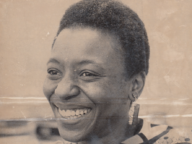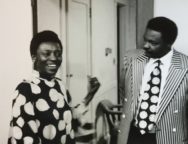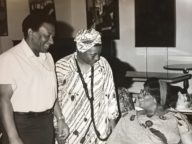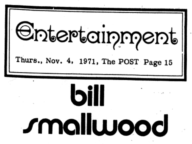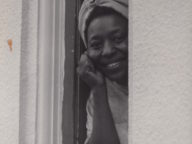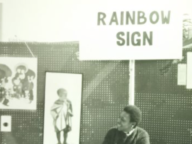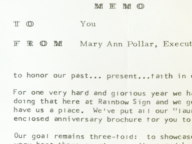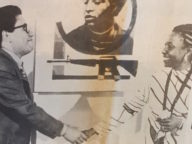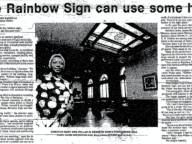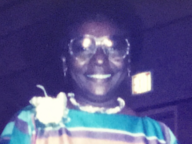Mary Ann Pollar
She had “the best smile there ever was—just the best”: so Odette Pollar described her mother Mary Ann Pollar, an eminent music promoter and the founder of Rainbow Sign, a pioneering Black cultural center active between 1971 and 1977 in Berkeley.
That warmth, still visible in faded photographs, shaped the charisma and vision that radiated out from Pollar. Multi-talented and magnetic, Pollar brought the best of folk music to Bay Area audiences, established a one-of-a-kind center for Black Arts and culture, and made strides as a union organizer in the public sector—all with a grace that belied the discrimination she faced as an African-American woman of her time.
Before the Rainbow
Pollar descended from a family of Baptist preachers and was raised at first in a Texas town near the Mexico border. At twelve, she moved with her family to Chicago and stayed in the area for college, attending Roosevelt College (a progressive school that counted Marian Anderson, Ralph Bunche, Albert Einstein, and Thomas Mann on its advisory board) and pursuing a degree in labor education.
In 1950 Pollar moved to the Bay Area, where she quickly became immersed in the burgeoning folk music scene. Going to shows became postering for shows, which led her to work on the ticketing of shows, and then to take on the task of full-on promoting.
Unlike many music promoters of the time, Pollar was beloved by artists themselves, who appreciated her extraordinary geniality. Perhaps her strongest such attachment was with her lifelong friend, the folk singer Odetta (for whom her daughter Odette was named in 1955). It was also partly due to Odetta, and the enjoyment Pollar had in promoting her, that “mary ann pollar presents“ was born.
Pollar’s skill with people was matched by her skill at business: her incorporated production company swiftly gathered momentum and began to draw large audiences.
Despite the stresses of promoting, Pollar never lost her passion and enthusiasm for the music and the artists. It helped that mary ann pollar presents was not her family’s sole source of income; husband Henry Pollar worked as an engineer for Bechtel Construction during those years. Mary Ann Pollar was able to trust her own tastes, “to pick and choose what I call the goodies,” as she told Ron Cohen in 1993. She could focus on presenting artists whom she liked and admired, not just artists who would draw a large gross.

Henry Pollar, Odetta, and Wanda Jean Price
Pollar chose acts, she said, because she thought “they were part of the solutions, that the things they sang about, the message they had, was an important message…There were some performers I loved to dance to, or whatever…But I didn’t like the message.” Music, message and good fortune came together auspiciously for Pollar in 1965 when she produced Bob Dylan’s first show on the west coast.
“She’s the only person I know, that a musician would take her personal check… after they performed.”
— Rainbow Sign manager Charles Brown
However, it cannot be forgotten that this luminous personality and whip-smart acumen belonged to a Black woman, and this led to challenges for Pollar. Racism, both subtle and overt, came at her from many sides. Routinely underestimated and undervalued by whites, she also caught flak from some members of the Black community who couldn’t understand why she promoted white artists as well as Black ones.
Through it all, Pollar remained graceful and positive. Her friend Electra Price remembers the two of them laughing at the absurd expectations about black women that they encountered, and shattered, from day to day: Pollar laughed inside, for example, at the dumbstruck looks she received when she broke out in her fluent Spanish, a product of her days growing up in a Texas bordertown.
Pollar’s bilingualism and natural hair and bright dresses were certainly exceptional, but it was her finesse in dealing with people that set her apart. Nevertheless, the task of securing venues for her shows became increasingly difficult as more assertive white male concert promoters began taking over the area.
“Mary Ann could walk through and do whatever she wanted to do. She’d put somebody in their place if she had to. And if not, her presence, her manner and her capabilities spoke for themselves.”
— Electra Price
Many rock music fans today are familiar with the names Chet Helms and Bill Graham, but with the exception of a couple of tiny mentions in Dylan biographies, Mary Ann Pollar has remained largely unknown. This is remarkable considering the long roster of now-famous performers who were first introduced to the Bay Area by Pollar. To list only a few: Joan Baez, Judy Collins, The Clancy Brothers, Arlo Guthrie, Curtis Mayfield, Pete Seeger, Peter Paul and Mary, Buffy St. Marie, Simon and Garfunkel, Nina Simone, and Frank Zappa.

Pollar’s humility is evinced by her advertisements, like this one which ran in the Daily Cal in 1971. The phrase “mary ann pollar presents”—always in lower case letters—is barely visible in the upper right corner.
Pollar’s style of business was much gentler than that of the notoriously bull-headed Graham. While she may not have been able or inclined to elbow her way to the front of the pack, she was able to maintain flourishing relationships with artists and entertainers, something that served her well in her next endeavor.
The Dream of the Rainbow Sign
Pollar continued to produce concerts up into the early 1980s, but in 1970 her primary focus shifted to realizing her long-held dream of having her own venue, described in the Oakland Post as “a warm and gracious environment in which to present young artists –– a place not so big as to be overwhelming and not so small that its facilities would be inadequate.”
More than just a music venue, Pollar envisioned an art gallery, cultural center, meeting place, and restaurant. She scoured Oakland and Berkeley for a property to suit her purpose and finally settled on a dilapidated funeral home on Grove Street (now Martin Luther King, Jr. Way) in Berkeley.
“You must be out of your mind,” Electra Price said as they pulled up. “You’re going to put a restaurant in a mortuary?”
Pollar’s friend and assistant Charles Brown was equally suspect, but Pollar’s confidence in her vision was unswerving. After a great deal of refurbishment, Rainbow Sign opened to the public in August 1971. Soon everyone forgot about the building’s funereal past.
Mary Ann Pollar’s Black cultural center served all kinds of people. It became not only the locus for Bay Area intellectuals, artists and socialites, but fast became the place to be for visiting personages of national and international acclaim. TV and film stars, African dignitaries, politicians and radical artists all came to the Rainbow Sign.
Advertised as being open until “at least 10pm,” Rainbow Sign’s lights were often on into the wee hours as it was usually the site for the after-party of major concerts with everyone from Stevie Wonder to Gladys Knight. The very next day, there would be families eating lunch in the restaurant, school board members discussing the budget, and free photography classes for teens.
Rainbow Sign was as multivalent and creative as Mary Ann Pollar herself, but it required a difficult balancing act. Run as a nonprofit, the center relied on membership dues. Under the pressure of the economic recession of the late-70s, the Rainbow Sign closed in 1978.
A Last Professional Chapter: Union Organizer and President
Never down for long, the indefatigable Mary Ann Pollar soon launched into yet another career serving her community. She began working for AC Transit where she organized a new union, AFSCME Local 3916, to which she was elected president, serving with distinction. Pollar stayed with AC Transit for twenty years, using her phenomenal people skills and organizational prowess to negotiate for the rights of workers and their families. She retired in 1999, shortly following the death of her husband. She herself passed later that year.
“Mary Ann had a charisma that could lead. She could’ve been a queen on a throne, you know– “Do!” But she was never pushy: she was firm, and she believed in what she was doing. She would listen to you if you had any criticisms, but she would go right on ahead and do what needed to be done.”
— Electra Price
In addition to running the Rainbow Sign, being a tastemaker and “whirlwind-busy impresario,” Mary Ann Pollar was a personal inspiration to those who knew her. She had a way about her that brought people together—people who discovered, through her, that they had the same wishes, goals and desires. The crowds at Rainbow Sign and the audiences at her concerts were always integrated.
The musicians, artists, and writers who constellated around her did so, in no small part, because of their fondness for her. She put her own personal stamp on everything she accomplished and built. And yet this great orchestrator of audiences had little need to be herself the center of attention—which might explain why her name is not as well-known as it deserves to be. “She was quiet,” Charles Brown recalled. “She was well liked by everybody.”
— Tessa Rissacher
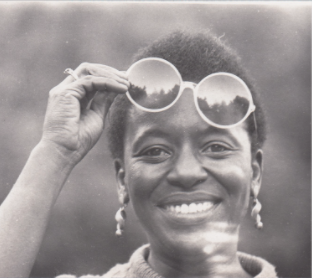
Mary Ann Pollar beaming with bright vision behind stylish shades
